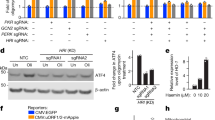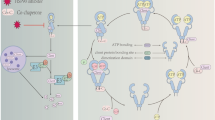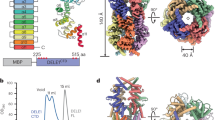Abstract
Heat shock protein 70 (HSP70) can inhibit apoptosis by neutralizing and interacting with apoptosis-inducing factor (AIF), a mitochondrial flavoprotein that translocates upon apoptosis induction to the nucleus, via the cytosol. Here, we show that only members of the HSP70 family interact with AIF. Systematic deletion mapping revealed the existence of three distinct functional regions in the AIF protein: (1) a region between amino acids 150 and 228 that binds HSP70, (2) a domain between residues 367 and 459 that includes a nuclear localization sequence (NLS) and (3) a C-terminal domain beyond residue 567 required for its chromatin-condensing activity. Deletion of the 150–268 domain completely abolished HSP70 binding and facilitated the nuclear import of AIF, resulting in a gain-of-function phenotype with enhanced AIF-mediated chromatin condensation as compared to wild-type AIF. This gain-of-function phenotype was observed in wild-type control cells (which express low but significant levels of HSP70), yet was lost when AIFΔ150–268 was introduced into HSP70 knockout cells, underscoring the functional importance of the AIF–HSP70 interaction. Altogether, our data demonstrate that AIF inhibition by HSP70 involves cytosolic retention of AIF. Moreover, it appears that endogenous HSP70 protein levels are sufficiently elevated to modulate the lethal action of AIF.
This is a preview of subscription content, access via your institution
Access options
Subscribe to this journal
Receive 50 print issues and online access
$259.00 per year
only $5.18 per issue
Buy this article
- Purchase on SpringerLink
- Instant access to full article PDF
Prices may be subject to local taxes which are calculated during checkout







Similar content being viewed by others
References
Beckmann RP, Mizzen LE and Welch WJ . (1990). Science, 248, 850–854.
Beere HM, Wolf BB, Cain K, Mosser DD, Mahboubi A, Kuwana T, Tailor P, Morimoto RI, Cohen GM and Green DR . (2000). Nat. Cell. Biol., 2, 469–475.
Castedo M, Ferri KF, Blanco J, Roumier T, Larochette N, Barretina J, Amendola A, Nardacci R, Metivier D, Este JA, Piacentini M and Kroemer G . (2001). J. Exp. Med., 194, 1097–1110.
Courchesne PL, Jones MD, Robinson JH, Spahr CS, McCracken S, Bentley DL, Luethy R and Patterson SD . (1998). Electrophoresis, 19, 956–967.
Daugas E, Susin SA, Zamzami N, Ferri KF, Irinopoulou T, Larochette N, Prevost MC, Leber B, Andrews D, Penninger J and Kroemer G . (2000). FASEB J., 14, 729–739.
Ferri KF, Jacotot E, Blanco J, Este JA, Zamzami N, Susin SA, Xie Z, Brothers G, Reed JC, Penninger JM and Kroemer G . (2000). J. Exp. Med., 192, 1081–1092.
Ferri KF and Kroemer G . (2001). Nat. Cell. Biol., 3, E255–E263.
Garrido C, Bruey JM, Fromentin A, Hammann A, Arrigo AP and Solary E . (1999). FASEB J., 13, 2061–2070.
Garrido C, Gurbuxani S, Ravagnan L and Kroemer G . (2001). Biochem. Biophys. Res. Commun., 286, 433–442.
Gurbuxani S, Bruey JM, Fromentin A, Larmonier N, Parcellier A, Jaattela M, Martin F, Solary E and Garrido C . (2001). Oncogene, 20, 7478–7485.
Hu Y, Benedict MA, Ding L and Nunez G . (1999). EMBO J., 18, 3586–3595.
Jaattela M . (1995). Int. J. Cancer, 60, 689–693.
Jacobson MD, Weil M and Raff MC . (1997). Cell, 88, 347–354.
Joza N, Susin SA, Daugas E, Stanford WL, Cho SK, Li CY, Sasaki T, Elia AJ, Cheng HY, Ravagnan L, Ferri KF, Zamzami N, Wakeham A, Hakem R, Yoshida H, Kong YY, Mak TW, Zuniga-Pflucker JC, Kroemer G and Penninger JM . (2001). Nature, 410, 549–554.
Kroemer G and Reed JC . (2000). Nat. Med., 6, 513–519.
Li P, Nijhawan D, Budihardjo I, Srinivasula SM, Ahmad M, Alnemri ES and Wang X . (1997). Cell, 91, 479–489.
Loeffler M, Daugas E, Susin SA, Zamzami N, Metivier D, Nieminen AL, Brothers G, Penninger JM and Kroemer G . (2001). FASEB J., 15, 758–767.
Marzo I, Brenner C, Zamzami N, Susin SA, Beutner G, Brdiczka D, Remy R, Xie ZH, Reed JC and Kroemer G . (1998). J. Exp. Med., 187, 1261–1271.
Miramar MD, Costantini P, Ravagnan L, Saraiva LM, Haouzi D, Brothers G, Penninger JM, Peleato ML, Kroemer G and Susin SA . (2001). J. Biol. Chem., 276, 16391–16398.
Munster PN, Basso A, Solit D, Norton L and Rosen N . (2001). Clin. Cancer Res., 7, 2228–2236.
Murakami H, Pain D and Blobel G . (1988). J. Cell. Biol., 107, 2051–2057.
Nylandsted J, Rohde M, Brand K, Bastholm L, Elling F and Jaattela M . (2000). Proc. Natl. Acad. Sci. USA, 97, 7871–7876.
Ravagnan L, Gurbuxani S, Susin SA, Maisse C, Daugas E, Zamzami N, Mak T, Jaattela M, Penninger JM, Garrido C and Kroemer G . (2001). Nat. Cell. Biol., 3, 839–843.
Seo JS, Park YM, Kim JI, Shim EH, Kim CW, Jang JJ, Kim SH and Lee WH . (1996). Biochem. Biophys. Res. Commun., 218, 582–587.
Shi Y and Thomas JO . (1992). Mol. Cell. Biol., 12, 2186–2192.
Solary E, Droin N, Bettaieb A, Corcos L, Dimanche-Boitrel MT and Garrido C . (2000). Leukemia, 14, 1833–1849.
Susin SA, Lorenzo HK, Zamzami N, Marzo I, Snow BE, Brothers GM, Mangion J, Jacotot E, Costantini P, Loeffler M, Larochette N, Goodlett DR, Aebersold R, Siderovski DP, Penninger JM and Kroemer G . (1999). Nature, 397, 441–446.
Volloch VZ and Sherman MY . (1999). Oncogene, 18, 3648–3651.
Wang X, Yang C, Chai J, Shi Y and Xue D . (2002). Science, 298, 1587–1592.
Ye H, Cande C, Stephanou NC, Jiang S, Gurbuxani S, Larochette N, Daugas E, Garrido C, Kroemer G and Wu H . (2002). Nat. Struct. Biol., 9, 680–684.
Acknowledgements
We thank Clayton R Hunt (Department of Radiation Oncology, Washington University School Of Medicine, St Louis, MO 63108, USA), David J Dix (National Health and Environmental Effects Research Laboratory, US Environmental Protection Agency, NC 27711, USA) and Marja Jäättelä (Danish Cancer Society, DK-2100, Copenhagen, Denmark) for the MEF HSP70.1, HSP70.3-deficient cells. This work was supported by the Institut National pour la Santé et la Recherche Medicale (INSERM), the Comité Départemental de la Nièvre de la Ligue National contre le Cancer, the Association pour la Recherche contre le Cancer (ARC # 9567 and 5204), the Conseil Régional de Bourgogne (to CG), Ligue Nationale contre le Cancer and the European Commission (QLG1-CT-1999-00739) (to GK). SG was supported by a Poste vert from the INSERM, AP by a fellowship from the Ministère de l'Education Nationale and CC by a fellowship from ARC.
Author information
Authors and Affiliations
Corresponding author
Rights and permissions
About this article
Cite this article
Gurbuxani, S., Schmitt, E., Cande, C. et al. Heat shock protein 70 binding inhibits the nuclear import of apoptosis-inducing factor. Oncogene 22, 6669–6678 (2003). https://doi.org/10.1038/sj.onc.1206794
Received:
Revised:
Accepted:
Published:
Issue Date:
DOI: https://doi.org/10.1038/sj.onc.1206794
Keywords
This article is cited by
-
BARX1 promotes osteosarcoma cell proliferation and invasion by regulating HSPA6 expression
Journal of Orthopaedic Surgery and Research (2023)
-
Analysis of potential regulatory LncRNAs and CircRNAs in the oxidative myofiber and glycolytic myofiber of chickens
Scientific Reports (2021)
-
Heat shock proteins-driven stress granule dynamics: yet another avenue for cell survival
Apoptosis (2021)
-
Cell Death and Recovery in Traumatic Brain Injury
Neurotherapeutics (2020)
-
Mechanisms of protein homeostasis (proteostasis) maintain stem cell identity in mammalian pluripotent stem cells
Cellular and Molecular Life Sciences (2018)



